
A postage stamp is a small piece of paper issued by a post office, postal administration, or other authorized vendors to customers who pay postage. Then the stamp is affixed to the face or address-side of any item of mail—an envelope or other postal cover —which they wish to send. The item is then processed by the postal system, where a postmark or cancellation mark—in modern usage indicating date and point of origin of mailing—is applied to the stamp and its left and right sides to prevent its reuse. Next the item is delivered to its addressee.

Stamp collecting is the collecting of postage stamps and related objects. It is an area of philately, which is the study of stamps. It has been one of the world's most popular hobbies since the late nineteenth century with the rapid growth of the postal service, as a stream of new stamps was produced by countries that sought to advertise their distinctiveness through their stamps.

A cancellation is a postal marking applied on a postage stamp or postal stationery to deface the stamp and to prevent its reuse. Cancellations come in a huge variety of designs, shapes, sizes, and colors. Modern cancellations commonly include the date and post office location where the stamps were mailed, in addition to lines or bars designed to cover the stamp itself. The term "postmark" refers specifically to the part that contains the date and posting location, but the term is often used interchangeably with "cancellation" as it may serve that purpose. The portion of a cancellation that is designed to deface the stamp and does not contain writing is also called the "obliteration" or killer. Some stamps are issued pre-cancelled with a printed or stamped cancellation and do not need to have a cancellation added. Cancellations can affect the value of stamps to collectors, positively or negatively. Cancellations of some countries have been extensively studied by philatelists, and many stamp collectors and postal history collectors collect cancellations in addition to the stamps themselves.

Philatelic literature is written material relating to philately, primarily information about postage stamps and postal history.
The Scott catalogue of postage stamps, published by Scott Publishing Company, now a subsidiary of Amos Media, is updated annually and lists all the stamps of the world that its editors recognize as issued for postal purposes. It is published in fourteen large volumes that include twelve volumes containing all the countries of the world that have ever issued postage stamps, the United States Specialized Catalog, and the 1840–1940 Classic Specialized Catalogue. The numbering system used by Scott to identify stamps is dominant among stamp collectors in the United States, Canada and Mexico.

A piece of postal stationery is a stationery item, such as a stamped envelope, letter sheet, postal card, lettercard, aerogram or wrapper, with an imprinted stamp or inscription indicating that a specific rate of postage or related service has been prepaid. It does not, however, include any postcard without a pre-printed stamp, and it is different from freepost for preprinted cards issued by businesses. In general, postal stationery is handled similarly to postage stamps; sold from post offices either at the face value of the printed postage or, more likely, with a surcharge to cover the additional cost of the stationery. It can take the form of an official mail issue produced only for the use of government departments.

The Penny Red was a British postage stamp, issued in 1841. It succeeded the Penny Black and continued as the main type of postage stamp in the United Kingdom of Great Britain and Ireland until 1879, with only minor changes to the design during that time. The colour was changed from black to red because of difficulty in seeing a cancellation mark on the Penny Black; a black cancellation mark was readily visible on a Penny Red.
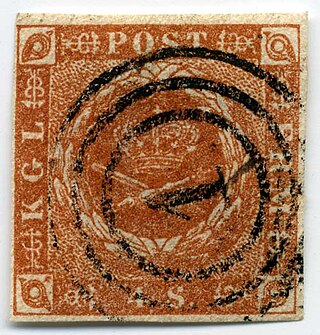
This is an overview of the postage stamps and postal history of Denmark.

A stamp catalog is a catalog of postage stamp types with descriptions and prices.

In philately, the term cover pertains to the outside of an envelope or package with an address, typically with postage stamps that have been cancelled and is a term generally used among stamp and postal history collectors. The term does not include the contents of the letter or package, although they may add interest to the item if still present. Cover collecting plays an important role in postal history as many covers bear stamps, postmarks and other markings along with names and addresses all of which help to place a cover at a given time and place in history.
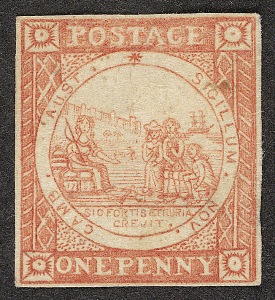
This is a survey of the postage stamps and postal history of New South Wales, a former British colony now part of Australia.
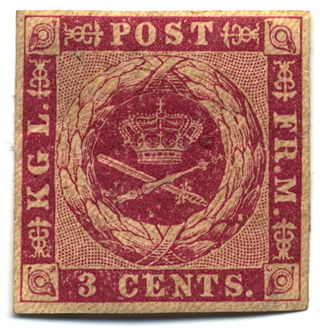
St Thomas was a hub of the West Indies packet service from 1851 to 1885. Initially mail was transported by a Spanish packet to and from Puerto Rico; but in July 1867 the British picked up the mail contract, and packet letters are known using British stamps as late as 1879.

A grill on a postage stamp is an embossed pattern of small indentations intended to discourage postage stamp reuse. Used in the United States in the 1860s and 1870s, they were designed to allow the ink of the cancellation to be absorbed more readily by the fibres of the stamp paper, making it harder to wash off the cancellation.

In general, philatelic fakes and forgeries are labels that look like postage stamps but have been produced to deceive or defraud. Learning to identify these can be a challenging branch of philately.

A stamp dealer is a company or an individual who deals in stamps and philatelic products. It also includes individuals who sell postage stamps for day to day use or revenue stamps for use on court documents. Stamp dealers who sell to stamp collectors and philatelists are of many kinds and their businesses range from small home operations to large international companies.
Lamy is a German fountain pen brand and producer.
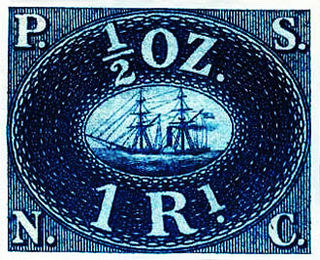
In Pre-Columbian times, the Inca Empire relied on messengers named chasquis for official communications; the chasquis used a special stone-paved road named Capac Ñan, and quipus, cotton or camelid fiber strings, collecting data with a special pattern of knots and colors. After the Spanish conquest of Peru, the old Inca system was preserved in their basics, still using chasquis and Capac Ñan, but without quipus deemed as “tool for idolatries” by Spanish colonial authorities, founding the rich Viceroyalty of Perú. In 1821, Peru declared independence from Spain and decisively defeated colonial forces at the Battle of Ayacucho in 1824.

Coded postal obliterators are a type of postmarks that had an obliterator encoded with a number, letter or letters, or a combination of these, to identify the post office of origin. They were introduced in the United Kingdom of Great Britain and Ireland in 1843, three years after the first stamp was issued. They became common throughout the nineteenth century but very few remained in use until the twentieth century.
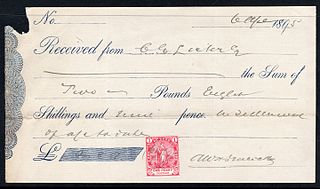
Cape of Good Hope issued revenue stamps from 1864 to 1961. There were a number of different stamps for several taxes.
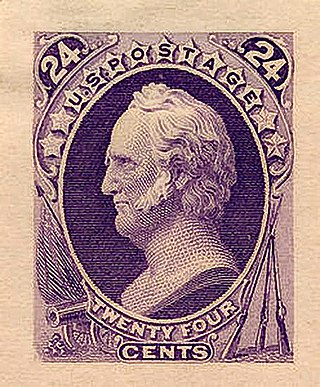
The Lost Continental is a light-purple 24¢ United States postage stamp depicting General Winfield Scott, printed around 1873 on vertically ribbed paper by the Continental Banknote Company. It is the only known copy of this 24¢ Scott stamp—among the many surviving examples—that can be positively identified as a printing by the Continental firm, and not by the National Banknote Company, which had originally produced this 24¢ issue three years earlier. For more than a century, experts could not determine with certainty whether Continental had ever, in fact, printed its own version of this stamp—or, if it had done so, whether any of the copies it printed survived. Conclusive evidence did not begin to emerge until a collector named Eraldo Magazzu discovered the Lost Continental while examining a lot of old stamps he had purchased in 1967. Much debate and analysis followed before the stamp, on the evidence of its paper-type, was finally certified as authentic by the Philatelic Foundation in 1992. How many other copies of this Scott issue printed on normal paper by Continental still exist is a question that philatelists believe will never be answered. Despite this uncertainty about the stamp's actual degree of rarity, the Lost Continental sold for $325,000 at a Siegel Gallery auction in December, 2004 A photograph of the stamp appeared on the front cover of the catalogue for that auction; on page 60 of the catalogue, a photograph of the Lost Continental's back shows the pencil mark "153", a Scott catalogue number that erroneously identifies the stamp as an example printed by the National Banknote Company.

















